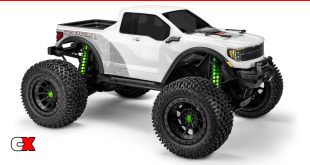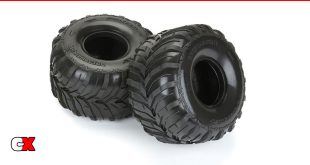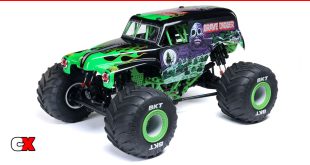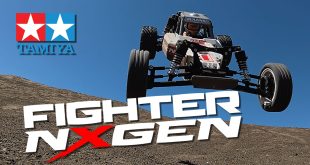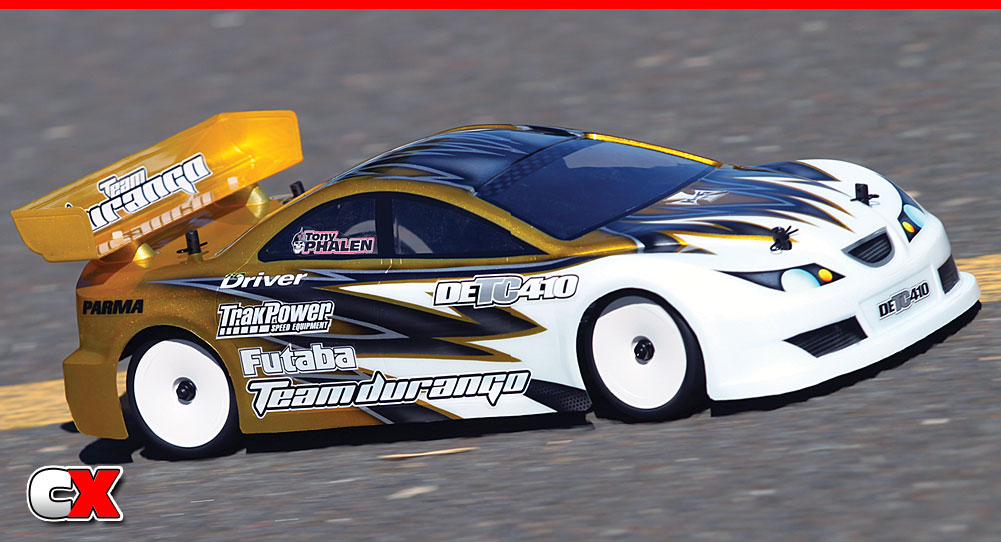
Touring cars have always been one my favorite classes to drive (and race). There’s something cool about driving a 4WD land missile on a tight track at break-neck speeds, all while avoiding the barriers, the marshals and the other competitors’ cars. When I got the word that I’d be reviewing Team Durango’s first touring car entry, the DETC410, I was pretty excited seeing as their off-road offerings are pretty stellar. Thankfully, I wasn’t disappointed. Read on to see why!
AT A GLANCE
WHO MAKES IT: Team Durango
WHO IT’S FOR: Experienced Racers
PART NUMBER: TD102023
HOW MUCH: $399.99
BUILD TYPE: Kit

FEATURE BREAKDOWN
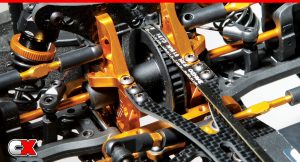 • The chassis of the DETC410 is very similar to all the other TC’s out there; a 2.25mm carbon fiber plank creates the platform for a host of gold-anodized aluminum goodies. The beautifully-colored front and rear bulkheads are screwed in place and stiffened by a 2mm, single-piece top deck. This top deck also attaches to the center bulkhead/motor mount, and features a ball-bearing supported, adjustable belt tensioner up top. Room on the left side of the chassis might be a little tight for electronics but thankfully I opted to use a shorty Futaba servo which freed up some space. On the battery side, an adjustable mounting system allows you to install the pack in four different locations to correct weight bias. This system also requires you to use tape to keep the battery in place.
• The chassis of the DETC410 is very similar to all the other TC’s out there; a 2.25mm carbon fiber plank creates the platform for a host of gold-anodized aluminum goodies. The beautifully-colored front and rear bulkheads are screwed in place and stiffened by a 2mm, single-piece top deck. This top deck also attaches to the center bulkhead/motor mount, and features a ball-bearing supported, adjustable belt tensioner up top. Room on the left side of the chassis might be a little tight for electronics but thankfully I opted to use a shorty Futaba servo which freed up some space. On the battery side, an adjustable mounting system allows you to install the pack in four different locations to correct weight bias. This system also requires you to use tape to keep the battery in place.
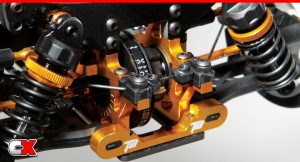 • The suspension on the DETC410 is not only gorgeous; it’s also uber-adjustable. The suspension arms rotate on hinge pins captured in gold-anodized arm mounts. These arm mounts can be raised or lowered and feature inserts to adjust toe. On both ends of the car, the camber, roll, damping location and even wheelbase are all adjustable. The belt tension can be tweaked by simply clocking the front or rear differential cams, and roll stiffness by changing out the anti-roll bars. Inserts in the steering knuckles control caster; inserts in the rear hubs modify the toe. All four arms have droop screws and the steering allows adjustment of Ackermann and bump. Like I said, there’s a lot to tweak on this car
• The suspension on the DETC410 is not only gorgeous; it’s also uber-adjustable. The suspension arms rotate on hinge pins captured in gold-anodized arm mounts. These arm mounts can be raised or lowered and feature inserts to adjust toe. On both ends of the car, the camber, roll, damping location and even wheelbase are all adjustable. The belt tension can be tweaked by simply clocking the front or rear differential cams, and roll stiffness by changing out the anti-roll bars. Inserts in the steering knuckles control caster; inserts in the rear hubs modify the toe. All four arms have droop screws and the steering allows adjustment of Ackermann and bump. Like I said, there’s a lot to tweak on this car
• The first thing you’ll notice about the steering is, of course, the gold-anodized rack supported on ball bearings. This is a nice feature and it includes all the typical adjustments. There are two other features that might not stick out so much; first, the servo is held in place by an interesting setup that captures the servo from both sides of the servo mounts. Once assembled, the mounting only attaches to this ‘cage’ using one side of the mounts; the other side hangs off the chassis and is not secured. In addition, double-sided tape is required to ‘level’ the servo. This seems to be a pretty solid system even if it is oddly designed. The other notable feature is Durango’s D-joint driveshafts. These super-efficient, aluminum shafts are designed to transfer power without vibration, and have an impressive 45-degree angle of drive. You should be able to max your EPA without the fear of driveshaft binding.
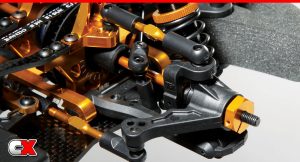 • The drivetrain on the DETC410 features a dual-belt drive system. Up front, this TC comes loaded with a fixed spool for maximum power transfer and the use of brakes. Out back, a fluid-filled gear differential is included, replacing the typical ball diff. This setup is quickly becoming the norm in TC’s, mainly for durability. The center bulkhead captures the spur gear assembly well. However, should you require a gear change, there is a lot of disassembly required. I built the 410 per the instructions but, after realizing I was using a 17.5T motor and most of the setups used a different spur, I decided I would change it. It basically required the removal of the entire top deck plus two additional screws; and don’t forget to keep track of the spacers for the motor mount. It’s not as big a deal as I’m making it out to be, but if you plan on running modified and stock in the same weekend, there is a significant amount of work involved.
• The drivetrain on the DETC410 features a dual-belt drive system. Up front, this TC comes loaded with a fixed spool for maximum power transfer and the use of brakes. Out back, a fluid-filled gear differential is included, replacing the typical ball diff. This setup is quickly becoming the norm in TC’s, mainly for durability. The center bulkhead captures the spur gear assembly well. However, should you require a gear change, there is a lot of disassembly required. I built the 410 per the instructions but, after realizing I was using a 17.5T motor and most of the setups used a different spur, I decided I would change it. It basically required the removal of the entire top deck plus two additional screws; and don’t forget to keep track of the spacers for the motor mount. It’s not as big a deal as I’m making it out to be, but if you plan on running modified and stock in the same weekend, there is a significant amount of work involved.
• Other than the spur gear, the rest of the car is pretty easily maintained. Both differentials can be accessed with the removal of four screws, the pinion can be released through a hole in the bottom of the chassis and the shocks pop right off of their ball ends.
PROS
+ Beautiful parts quality; the carbon fiber is accented perfectly by the gold aluminum parts
+ Spool up front is standard, as is the fluid-filled rear gear differential
+ Dual-belt drivetrain is extremely smooth and very efficient
+ Trick D-Joint front driveshafts
+ Tons of tuning options, most very easy to get to
+ Adjustable battery tray allows for weight-bias tuning
+ Holes in the ball cups allow you to move them to different locations without popping them off
+ Box-stock setup is pretty solid
CONS
– Changing the spur gear requires a lot of disassembly (more on that later)
– Had some issues with the servo saver (more on that later as well)
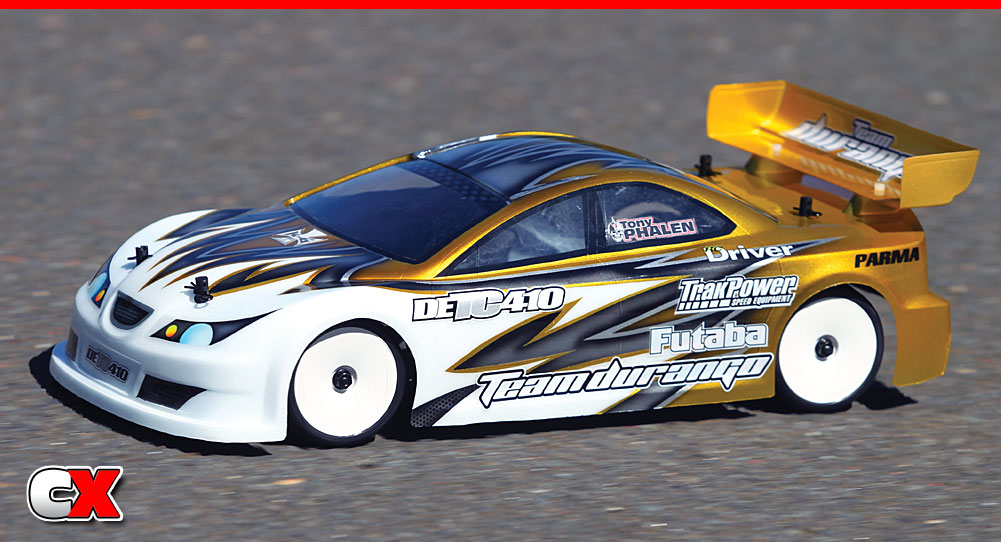
BEHIND THE WHEEL
Touring cars can be run on a few different track surfaces; basically asphalt, concrete or carpet. For this test I decided to give it a go on both asphalt and carpet; the two most common. As you’ll read, however, things didn’t go quite to plan.
STEERING
Before pulling the trigger on any test car, I always make sure things like toe and camber are squared away. The settings in the manual provided a touch of toe-in on the front, something I’m not a big fan of, so I shortened both the left and right steering turnbuckles slightly (and equally). I set the EPA’s for left and right, and put the car on the ground to see the turning radius. It was spot on (in both directions), but what I noticed right off the bat was the absence of binding when the wheels were at full lock. After a few slow laps (ok, more like one), I started powering around the track, pushing the DETC410 through the corners. Steering was responsive and, while it did exhibit a bit of understeer going into the corners, it was awesome mid and corner-exit.
ACCELERATION/BRAKING
Knowing I was going to put a 17.5T brushless motor in the DETC410, I did a little research on gearing and found that using the stock 116T was not going to cut it. I swapped out the spur to an 86T, installed an abnormally large pinion on the motor and set the timing to 30 degrees (on the motor). With a fully charged TrakPower 6000mAh LiPo installed, this TC has some definite rip. While there’s nothing ‘brutal’ about 17.5T horsepower, the MuchMore brushless system’s acceleration and top end was rather impressive. Even Walter, our resident photography stud, commented on how zippy the Durango looked. After the first pack I checked the motor temp and it felt lukewarm; a good indication that the gearing was in the acceptable range. I’m guessing a few more teeth or additional timing would really make this motor scream.
HANDLING
The handling of the DEX410 can only be described as exceptional. The setup is fantastic for asphalt. Not once did the car ever feel sketchy or out of balance. The MuchMore tires were glued to the pavement and gave me a bit of confidence, so much so that I really started pushing the car hard. Most of the track had flowing corners, but one section had a squared-off, double-apex corner that, if you took it just right, you could full speed it from corner to corner. My brave meter was filled to the brim, and lap after lap I was taking it faster and faster… until I ran out of luck.
DURABILITY
I’ll start off by saying that this car is solid. The part tolerances leave virtually no slop, the aluminum bits are beefy and well designed and everything fits the way it should. Now, that being said, let’s get to the aforementioned servo saver. This protective part is designed to keep the servo from stripping all the teeth in the event of a crash. This is the one part you pray does its job, but what happens if the servo saver fails without hitting anything? Apparently the servo saver cap, the part that is last in line before you screw it to the servo, broke free and disappeared somewhere on the track. This left the servo arm free to wiggle itself loose from the servo saver assembly; there was nothing left to hold it in place. Once these two pieces parted ways, there is basically no steering. Guess what part of the track this calamity happened … yup, right through the high speed, double-squared off corner. So, as I entered the corner, all was good until I just passed the first part of the corner and then disaster. The parts released and the DETC410 was headed, at full speed, mind you, right into the outside wall. Walter’s first comment was, “Why did you do that?” followed by my “That wasn’t me!” After I inspected the wreckage I found that the front right suspension arm had shattered; and I mean in a lot of pieces. The good news is that was the only broken part! The steering arm was intact as were the CVA, steering, shock towers and bulkheads. It was a serious hit and, as I said before, I’m not sure how many other TC’s would have survived. Upon closer inspection of the servo area, I noticed the screw was still in the servo. All I can think is that I may have had my gorilla gloves on when I tightened it down and stressed it out. This is not a typical part to fail.
SPECS & TUNING OPTIONS
DIMENSIONS
LENGTH: 14.4-in. (365mm)
WIDTH: 7.2-7.4-in. (192-189mm)
WHEELBASE: 10-10.3-in. (254-261mm)
WEIGHT: 47.6oz (1350g)
INTERNAL GEAR RATIO: 1.95:1
BODY, WHEELS AND TIRES
BODY: Not included
WHEELS: Not included
WHEEL ADAPTER TYPE: 12mm hex
TIRES: Not included
SUSPENSION
TYPE: 4-wheel independent
SHOCK POSITIONS: (F) 4-tower, 3-arm, (R) 4-tower, 3-arm
CAMBER: Adjustable turnbuckles
ROLL: Adjustable ball stud heights
WHEELBASE: Adjustable with shims
RIDE HEIGHT: Threaded shocks
MISC: Adjustable caster, kick, anti-squat, anti-dive
STEERING
TYPE: Dual bellcrank
TOE: Turnbuckles
CHASSIS
TYPE: Flat
MATERIAL: Carbon Fiber
THICKNESS: 2.25mm
DRIVETRAIN
TYPE: 4WD dual belt
TRANSMISSION: N/A
DIFFERENTIAL: (F) Spool, (R) Gear differential
CLUTCH TYPE: None
GEAR RATIO: Optional pinion gears
BEARINGS: Full shielded
WRAP UP
The DETC410 is extremely competitive right out of the box, and by that I mean build and setup. Other than the spur gear, this car was built per the instructions and it was dialed! I can’t wait to get some more time on it, play with some of the tuning options and even give it a boost in power. Even sitting on the workbench, the gold-anodized parts give this TC an upper-echelon look; like royalty should be driving it. Time to put my king’s crown on and do some laps.
LINKS
Futaba futaba-rc.com, (217) 398-8970
Kustom RC Graphics kustomrcgraphics.com, kustomrcgraphics@aol.com
MuchMore Racing, muchmoreusa.com, (217) 398-8970
Team Durango, team-durango.com, (217) 398-8970
TrakPower, trakpowerusa.com, (217) 398-8970
 CompetitionX CompetitionX is the most up-to-date source for RC Car News, Reviews and Videos for Radio Control. We also have the most comprehensive Manual Database on the web.
CompetitionX CompetitionX is the most up-to-date source for RC Car News, Reviews and Videos for Radio Control. We also have the most comprehensive Manual Database on the web.









